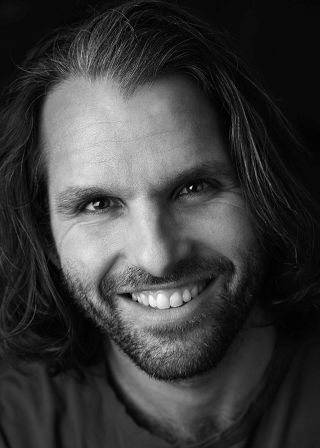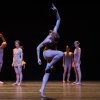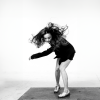Calling all balletomanes, fashionistas, and anyone seeking a thrilling night in the theater. On Oct. 2–4, Paris Opera Ballet (POB) performs the North American premiere of Red Carpet presented by Cal Performances at Zellerbach Hall on the UC Berkeley campus. Choreographed by Israeli-born, London-based Hofesh Shechter, the ballet — his first full-length opus for the Parisian company, one of the oldest and most revered in the world — features 13 dancers, costumes by Chanel, and an original score performed live by four musicians.
First seen in Paris at the Palais Garnier last June and July, Red Carpet is an opulent visual spectacle that aims to “celebrate the confusion between glamour and art,” according to Schecter. The choreographer, who, in addition to helming the Hofesh Shechter Company, is an associate artist at Sadler’s Wells Theatre in London, has had a hand in multiple parts of the production. He designed the set, which includes moving catwalks, epic chandeliers, and red curtains evoking the velvet of the Palais Garnier auditorium.
The 60-minute ballet boasts an aesthetic that’s been described as mixing glitz with grit, while Shechter’s choreographic palette runs the gamut from hyper-visceral to nuanced gestural language that manages to express the inexpressible. In other words, Red Carpet promises to be next level ballet.
No one knows that better than José Martinez, the Opera Ballet’s artistic director. Born in Spain in 1969, he danced with the company for 24 years, gaining his present position in 2022.
“It’s a big thing to be the director of Paris Opera Ballet,” he said. “We have 154 dancers and two theaters, and it’s a long, long season. We have a lot of projects and are not living just for the moment, but [I’m] thinking about the future of the company.”
Martinez, who headed the National Ballet of Spain for eight years before taking the reins at POB, had wanted to work with Shechter for years, but, he explained, “It was impossible, because he was always busy. With this opportunity in Paris, I thought that it was the right moment to do a full-length piece.” (Shechter had previously set three short works on the company.)
Martinez said that Schechter’s most important ask “was to have time with the dancers. Normally, in Paris, we have five weeks [rehearsal onstage],” he continued. “This time, I [also] gave him three weeks in October, [but even] after two months and a half, he spent all this time with the dancers in the studio. The musicians were also with him during the process, so it was a big thing for everyone.”
Martinez added that for the dancers, “it was interesting to be working with someone as fresh [as Shechter], because he wasn't looking at the ideal of classical beauty. He was working with classical dancers, but the idea is to show the personality of each dancer in this piece.”
Mickaël Lafon, who grew up in the south of France and entered the Paris Opera Ballet School in 1998 and was promoted to Sujet (mid-level rank) last year, wasn’t new to performing a Shechter work.
“The first time I met him, three or four years before we did [Red Carpet], he was really cool,” Lafon said. “When you work with him and go onstage, it’s powerful.”
Compared to other choreographers Lafon described the atmosphere as “totally different.”
“It’s more friendly,” he said. “We work a lot, [and] the process is hard on the body. You can’t fake it, you have to be fully in, because it’s about emotion, about body language. It’s not a step you learn like classic steps, like arabesques.
“It’s a different world,” continued Lafon, who, in a bit of perfect casting, is also a model for the luxury brand Missoni. “You have to be honest and give the best to be understood by the audience. It’s a lot about story.”

The story of Red Carpet veers between daydreams and decadent cabaret. Shechter, who’s staged and choreographed works on leading international dance troupes including Alvin Ailey American Dance Theater, Batsheva Dance Company, and the Royal Ballet, wrote in his program notes that the work “won’t provide answers or define meaning. It’s a playground for bringing questions and emotions to the surface. I don’t believe the role of dance is to provide solutions. A ballet must remain open, unresolved; that’s its beauty.”
That beauty, in addition to being personified by the extraordinary POB dancers, can also be found in the score by Shechter and his longtime collaborator Yaron Engler, which was conceived in tandem with the dance. A blend of ecstatic free jazz, Mediterranean sounds, and driving techno, the music is performed live onstage by cellist Olivier Koundouno, Marguerite Cox on double bass, Brice Perda on winds, and Engler on drums and, occasionally, vocals.
A graduate of Berklee College of Music, Engler lives in the south of England, and has worked with Shechter for several years, including on last year’s Theatre of Dreams. This was the first time, however, that he worked with the choreographer on a new piece for a company other than his.
When asked about their process for creating Red Carpet, Engler said that it started more with a visual reference than with the music.
“This was very different, because the show was created at the opera house in Paris,” he said. “That was a big driving force for the feel of the music, and Hofesh was looking for an ambience. From the beginning, it’s like you’re in the middle of a club and there’s a band playing.
“We then start to improvise,” Engler continued. “It builds very organically. Then Hofesh usually edits, and ideas start to bounce back and forth with the dancers. The Opera [staff] really liked the fact that we created it together, sometimes from the music, sometimes from the dance.”
The thread — no pun intended — that ties the ballet together is the costumes by Chanel. No stranger to dance when she was alive, in 1924 Coco Chanel designed the clothes for Le train bleu for Sergei Diaghilev’s Ballets Russes.
The costumes for Red Carpet, were inspired by both eveningwear and cabaret. Ranging from tuxedos, cocktail jackets, bow ties, and lamé gowns to embroidered and sequined fabrics that conjure the glamour of a celebratory night on the town, the costumes don’t hew to gender, blurring and blending masculine and feminine. In the course of the show, the six female and seven male dancers gradually peel off their outerwear, revealing shorter undergarments. Much like second skins, this allows for greater freedom of movement.
“Normally, Hofesh is using T-shirts,” Martinez said. “And when he told me, ‘Maybe I would like to work with Chanel,’ I said, ‘Are you sure?’ Dancers need to have solid, comfortable costumes and be completely free. Working with the Chanel team, something really beautiful happened; it was a fascinating encounter, and the costumes [also] became part of Hofesh’s visual language. They contribute to the dramaturgy and emotion, and in addition to that, Chanel is the principal patron of Paris Opera Ballet,” he explained.
“ Production values aside, Schecter’s way of working guarantees that the dance is new at each performance, Martinez said. “The musicians are improvising, so are the dancers. At the beginning, it’s kind of a dark cabaret party. At the end, we go into something much more emotional.”
He added. “I think that’s also new with Hofesh, that the audience will have poetical emotion.”




